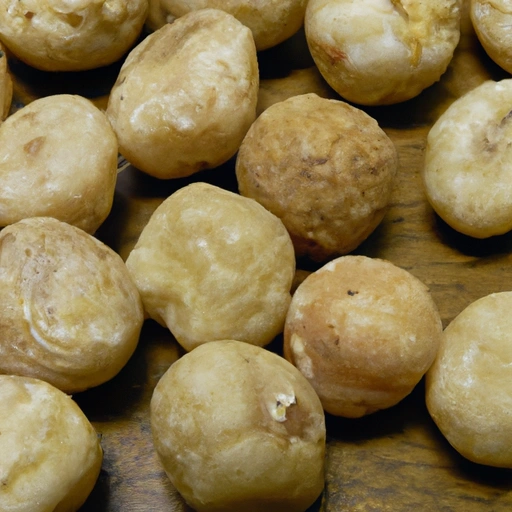Candlenut
Description

The candlenut, also known as kukui nut in Hawaii, is an edible seed of the candlenut tree (Aleurites moluccanus), which is native to the tropical regions of the Southeast Asia and Pacific. These nuts have a hard shell and a high oil content, making them a valuable ingredient in cooking and traditional medicine. Candlenuts are often ground into a paste and used as a thickening agent in sauces, curries, and soups. Their rich, creamy texture and slightly bitter taste add depth to a variety of dishes.
Common uses
Candlenuts are commonly ground into a paste and added to thicken and flavor sauces, curries, and soups. They may also be roasted and chopped for use in rice dishes, desserts, or as a garnish. In some Pacific and Asian traditions, candlenuts serve as a key ingredient in spice pastes or condiments, such as the Indonesian sambal.
Nutritional value
Calories
A one-ounce (28 grams or approximately 2 tablespoons) serving of candlenuts contains about 175 to 200 calories.
Protein
This same serving size provides around 2 to 3 grams of protein.
Fat
Candlenuts are high in fat, with roughly 18 to 20 grams per ounce, predominately comprised of monounsaturated and polyunsaturated fatty acids.
Carbohydrates
Carbohydrates are minimal in candlenuts, typically less than 2 grams per ounce.
Vitamins
Candlenuts are a source of vitamins like Vitamin E and some B vitamins in trace amounts.
Minerals
They contain minerals such as potassium, phosphorus, and magnesium, as well as trace amounts of calcium and iron.
Health benefits
Due to their high content of healthy fats, candlenuts may contribute to improved heart health and cholesterol levels. The presence of Vitamin E serves as an antioxidant that can help protect the body from free radicals. However, as with any high-fat food, moderation is key in reaping these health benefits.
Potential risks
Candlenuts should not be consumed raw due to the presence of toxic compounds that can cause illness. It is important to cook them thoroughly before consumption. Additionally, their high fat content means they should be eaten in moderation, especially by individuals managing obesity or heart disease.
Common recipes
Candlenuts are featured in recipes like Indonesian rendang, Malaysian laksa, and Hawaiian poke.
Cooking methods
Typically, candlenuts are roasted, ground, and then cooked as part of a dish. They must be cooked to remove any toxicity.
Pairing with other ingredients
They pair well with coconut milk, lemongrass, garlic, and other spices common to Southeast Asian and Polynesian cuisine.
Summary
Candlenuts are a versatile and rich ingredient integral to many Southeast Asian and Pacific dishes. When used properly, they contribute a creamy texture and a boost of healthy fats to meals. Despite their potential health benefits, they should be consumed cooked and in moderation due to their high fat content and the presence of natural toxins when raw.